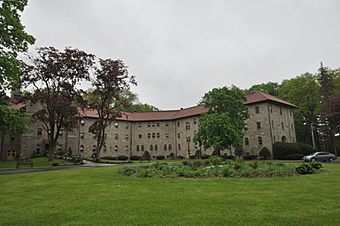Our Mother of Sorrows Monastery and Retreat Center (West Springfield, Massachusetts) facts for kids
Quick facts for kids |
|
|
Our Mother of Sorrows Monastery and Retreat Center
|
|
 |
|
| Location | West Springfield, Massachusetts |
|---|---|
| Architect | Comes, Perry, and McMullin |
| Architectural style | Mission/Spanish Revival |
| NRHP reference No. | 02000904 |
| Added to NRHP | August 30, 2002 |
The Our Mother of Sorrows Monastery and Retreat Center is a special old building in West Springfield, Massachusetts. It used to be a monastery for a group called the Passionists. A monastery is a place where religious people live and pray.
This building is unique because it's the only one of its kind in the city. It was also the first monastery built in western Massachusetts. Construction started in 1925, and it was made bigger in 1955.
For many years, until 1993, it was a Roman Catholic monastery and a place for people to go for quiet retreats. Today, it has been changed into a home for older adults. The building was added to the National Register of Historic Places in 2002 because of its history.
Contents
About the Building
The former Our Mother of Sorrows Monastery is located in a neighborhood north of downtown West Springfield. It sits on more than 18 acres (about 7.3 hectares) of pretty land.
The main building is very large and has five parts. It is built in a style called Spanish Colonial Revival. This means it looks like old Spanish buildings. It has a strong steel frame. The outside is made of brick and granite stone.
Many windows and doors on the first floor have rounded tops. Windows on the upper floors are rectangular. The roof is covered with red tiles. Three of the five parts of the building have more fancy designs. These are the oldest parts. The other two parts were added in 1955, making the building look like a big "C" shape.
History of the Passionists
The Passionist Order is a Roman Catholic group that started in 1720 in what is now Italy. By the early 1800s, the group had spread to countries where English is spoken. They came to the United States by 1852.
The number of Catholic people in Massachusetts grew a lot in the 1800s. This was because many people moved there from Ireland and Quebec. The first Passionist monastery in Massachusetts was in Boston. In 1922, the Passionists decided to build another one in western Massachusetts.
The building was designed by John T. Comes from Pittsburgh, Pennsylvania. He had designed other buildings for the Passionists before. The monastery in West Springfield is the biggest building in the area built in the Spanish Colonial style.
What the Monastery Did
From 1923 to 1993, the monastery had three main jobs.
- First, it was a home for the Passionist members. They lived a quiet life focused on work and prayer.
- Second, it was a place for priests to come for retreats. These priests worked with people all over the region. It was also a training place for new priests and monks.
- Later, the monastery also started offering weekend retreats for regular people, not just priests.
The monastery tried to be very self-sufficient. This means they grew most of their own food in gardens on the grounds. They also had a small clinic inside to care for sick members who did not need to go to a hospital.
Changes Over Time
As time went on, fewer people came to the retreats. The number of Passionist members living at the monastery also became smaller, and they grew older. In 1990, the monastery started to offer housing for older adults.
However, the religious functions of the monastery ended in 1993. The building was then closed. After that, the building was carefully fixed up to keep its historic look. Today, it works as a special home that helps older adults with their daily needs.
See also



